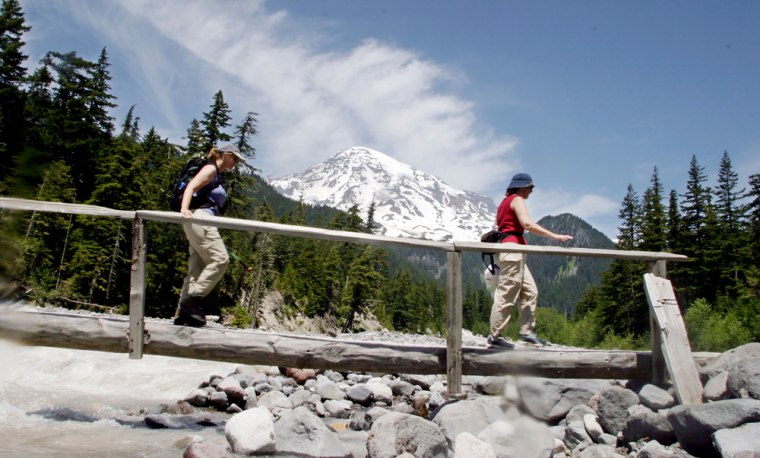You’ll have to excuse me; I seem to be having a MasterCard moment.
The National Park Service has just announced the first round of approved projects and programs under its ambitious National Park Centennial Initiative, and I can’t get those credit card commercials out of my head.
Preserving a backcountry hiking shelter at Mount Rainier National Park: $10,000;
Rebuilding populations of endangered Kemp’s Ridley sea turtles at Padre Island National Seashore: $222,000;
Restoring ancient redwood forests and watersheds in Redwood National Park: $3 million;
Improving visitors’ experiences, inspiring a sense of stewardship and implementing a public-private partnership to improve America’s national parks: Priceless.
At least that’s the idea behind the initiative, a 10-year, $2-billion plan designed to enhance the National Park system as it approaches its 100th anniversary in 2016. Originally unveiled two years ago, the proposal took a major step forward today when Secretary of the Interior Dirk Kempthorne announced the 110 projects approved for this year.
Protecting parks though public-private partnerships
As originally conceived, the plan invited park staffers, conservation groups and others to propose projects that emphasized stewardship, environmental leadership, recreational experiences and other “centennial goals.” It also called for $100 million per year in government funding for 10 years, provided the funds are matched by private donations. (Non-governmental matching funds were a requirement for consideration.)
According to spokesman Jeff Olson, the Park Service received more than 300 proposals for 2008. They also received an impressive $216 million in financial commitments from park visitors, friends groups and other potential partners.
Congress, alas, has yet to step up to the same level, authorizing an initial $24.6 million for this year. (The $100 million/year figure is part of the administration’s proposed 2009 budget.) On the bright side, that’s already been matched by $27 million in private donations. According to Olson, the combined $51.6 million “will benefit 76 park units in 38 states and the District of Columbia.”
Among the approved projects:
- Reintroduce trumpeter swans and provide habitat learning experiences on the Buffalo National River (Arkansas): $4,000
- Digitally capture park sites before they deteriorate due to time and natural elements at Mesa Verde National Park (Colorado): $10,000
- Conduct Tulelake Basin video and oral history interviews at Lava Beds National Monument (California): $16,000
- Create podcasts to highlight recreational, educational and informational aspects of Lake Mead National Recreation Area (Arizona, Nevada): $30,000
- Construct interpretive trail and amphitheater at Carnivore Cove in Hagerman Fossil Beds National Monument (Idaho): $39,627
- Expand the sailing schedule of the Friendship of Salem, a 1797 replica ship, at Salem Maritime National Historic Site (Massachusetts): $45,000
- Restore and illuminate the South Manitou Island Lighthouse at Sleeping Bear Dunes National Lakeshore (Michigan): $81,000
- Rejuvenate coral reefs in Biscayne National Park (Florida): $110,000
- Construct Noonday Creek Bicycle/Pedestrian Trail at Kennesaw Mountain National Battlefield Park (Georgia): $1.2 million
- Rehabilitate the historic Tunnel View Overlook at Yosemite National Park (California): $3 million
- Restore disturbed lands, improve wetland habitat and remove exotic vegetation at Everglades National Park (Florida): $5.5 million
- Construct Wisconsin Avenue Plaza in Rock Creek Park (Washington, D.C.): $9 million
Benefits that go beyond park boundaries
While the above projects (and dozens of others) were developed to benefit individual parks, several are designed with larger, longer-term goals in mind. Increasingly, the Park Service is dealing with an aging population, more ethnically diverse visitors and children who are more attuned to technology than hiking trails. “We focused on projects that will have an immediate impact,” notes Olson, “but also ones that stretch that $24.6 million as far as possible.”
For example, Lewis and Clark National Historical Park (Oregon, Washington) will implement “Adopting the Class of 2016: Students to Stewards” ($60,000), which will allow up to 500 fourth graders to visit the park annually in an effort to inspire future stewardship. “Several other parks said, ‘What a great idea,’” says Olson, noting that the program will probably be rolled out in other parks in subsequent years.
Meanwhile, several parks will conduct “BioBlitzes” or All-Taxa Biodiversity Inventories (ATBI), in which staffers and volunteers will work together to tabulate native flora and fauna. “It’s a way to turn citizens into scientists,” says Olson. “People feel good about taking part, and we get a new cadre of dedicated volunteers and visitors.”
The idea is that those new visitors will reconnect with the parks and be more inclined to support them in the future. That, goes the thinking, could lead to more partnerships, more programs and more money for park improvements (and perhaps acquisitions) down the road.
That, of course, is dependent on the Centennial Initiative becoming law, proving its value and receiving its full appropriation. The Park Service still faces tremendous challenges, including budget shortfalls and maintenance backlogs totaling several billion dollars, but the $51 million in projects announced today is certainly welcome. It’s not the $2 billion the Park Service is hoping for (yet), but it’s a start.
